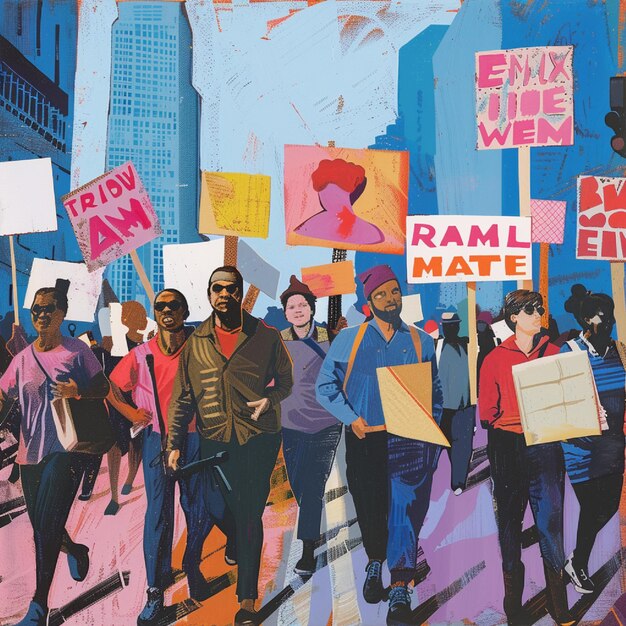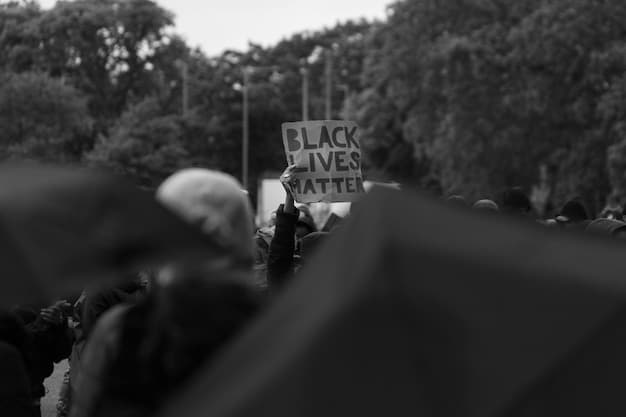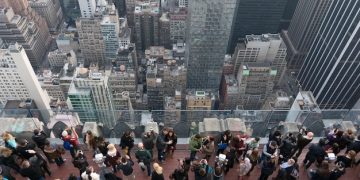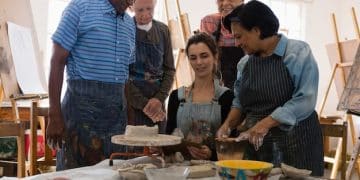Art as Activism: A Historical Look at Social Change

The role of art in social activism is multifaceted, serving as a powerful tool for expression, resistance, and change throughout history, reflecting societal shifts and inspiring movements.
Art has always been a reflection of society, but its power extends beyond mere representation. Throughout history, the role of art in social activism: a historical overview reveals how artistic expression has been a catalyst for change, a weapon against oppression, and a voice for the voiceless.
Art as a Mirror and a Hammer: Reflecting and Shaping Society
Art doesn’t just reflect society, it actively shapes it. From ancient cave paintings to modern street art, artists have always used their creativity to comment on, critique, and challenge the status quo. But how exactly does art influence social activism?
It provides a visual and emotional language that transcends barriers of language and literacy, allowing complex ideas to be communicated in a powerful and accessible way. Art can evoke empathy, inspire action, and create a sense of solidarity among those fighting for change.

The Power of Visual Communication
Visual art, in particular, has played a crucial role in social movements throughout history. Think of the iconic images of the Civil Rights Movement, or the powerful posters of the Suffragette movement. These images became shorthand for the issues at stake, galvanizing support and shaping public opinion.
Art as a Form of Resistance
Beyond communication, art can also be a direct form of resistance. Graffiti art, performance art, and even subversive crafts can be used to challenge authority, disrupt the dominant narrative, and create spaces for alternative voices.
- Raises Awareness: Art can make complex social issues more understandable and relatable to a wider audience.
- Inspires Action: Powerful imagery and storytelling can motivate people to get involved in social movements.
- Challenges Power: Art can subvert traditional power structures and give voice to marginalized communities.
- Creates Community: Shared artistic experiences can foster a sense of solidarity and belonging among activists.
In conclusion, art serves as both a mirror, reflecting the realities of society, and a hammer, shaping it towards a more just and equitable future. Its ability to communicate complex ideas, inspire action, and challenge power makes it an indispensable tool for social activists.
Early Examples: Art and Revolution in the 18th and 19th Centuries
The relationship between art and social change is not a modern phenomenon. It has deep roots in history, with examples dating back centuries. The 18th and 19th centuries, in particular, saw a surge in art used as a tool for revolution and social commentary. What are some key examples of this early activism?
These periods witnessed major social and political upheavals, from the French Revolution to the rise of abolitionism in the United States. Artists responded to these events by creating powerful works that challenged the established order and advocated for a more just society.
The French Revolution: Art as Propaganda
The French Revolution was a pivotal moment in European history, and art played a key role in shaping its narrative. Artists like Jacques-Louis David created monumental paintings that glorified the revolution and its leaders, while caricaturists used satire to mock the aristocracy and the monarchy.
Abolitionist Art in the United States
In the United States, the abolitionist movement used art to expose the horrors of slavery and to advocate for the freedom of enslaved people. Graphic images of enslaved people being whipped and branded were widely circulated, shocking the conscience of the nation and fueling the fight against slavery.
- Political Cartoons: Used to satirize political figures and events, influencing public opinion.
- Historical Paintings: Depicted key moments in revolutionary struggles, inspiring patriotism and sacrifice.
- Pamphlets and Broadsides: Illustrated with woodcuts and engravings, spreading messages of social reform to a wider audience.
In essence, the art of the 18th and 19th centuries served as a powerful weapon in the hands of revolutionaries and reformers, helping to shape public opinion and to advance the cause of social justice. These early examples laid the foundation for the more sophisticated and diverse forms of art activism that would emerge in the 20th and 21st centuries.
The 20th Century: Art as a Tool for Social and Political Commentary
The 20th century witnessed unprecedented social and political upheaval, from world wars to civil rights movements. Artists responded to these events with a wide range of innovative and impactful works that challenged traditional notions of art and its role in society. But how did these artists use their work to make a difference?
This era saw the rise of new artistic movements, such as Dadaism, Surrealism, and Pop Art, which often incorporated elements of social and political commentary. Artists used their work to critique consumerism, war, racism, and other social ills.

Art and the Anti-War Movement
The two World Wars and the Vietnam War inspired a surge of anti-war art, ranging from graphic depictions of the horrors of war to more subtle and symbolic critiques of militarism and nationalism. Artists like Pablo Picasso and Käthe Kollwitz created powerful images that captured the suffering and devastation caused by war.
Art and the Civil Rights Movement
In the United States, the Civil Rights Movement used art as a powerful tool for raising awareness and galvanizing support. Artists like Romare Bearden and Jacob Lawrence created works that celebrated African American culture and history, while also exposing the injustices of segregation and discrimination.
- Photography: Documented social injustices and brought them to the attention of a wider audience.
- Street Art: Used as a form of protest and to reclaim public spaces for marginalized communities.
- Performance Art: Created provocative and often confrontational experiences that challenged social norms.
In other words, the art of the 20th century became a powerful voice for social and political change, challenging the status quo and inspiring people to fight for a better world. Its legacy continues to influence contemporary art and activism today.
Contemporary Art and Social Activism: Current Trends
Today, art continues to be a vital force in social activism. Contemporary artists are using a variety of media and approaches to address pressing social and political issues, from climate change to immigration to police brutality. But what are some of the most effective strategies they are employing?
Contemporary art activism is often characterized by its participatory and collaborative nature. Artists are increasingly working with communities to create projects that address local needs and amplify marginalized voices.
The Rise of Socially Engaged Art
Socially engaged art is a growing movement that emphasizes the importance of collaboration and community involvement. Artists working in this field often create projects that are designed to address specific social problems, such as poverty, homelessness, or environmental degradation.
Art and Technology
Technology is also playing an increasingly important role in contemporary art activism. Artists are using digital media, social media, and online platforms to reach wider audiences and to create interactive and participatory experiences.
- Online Art: Uses internet platforms to disseminate information and engage with audiences.
- Community Projects: Focus on collaborative creation and social change within local communities.
- Interactive Installations: Invite audience participation and promote dialog about social issues.
To summarize, contemporary art activism is a dynamic and evolving field that is constantly adapting to new challenges and opportunities. By combining creativity, collaboration, and technology, artists are continuing to make a powerful contribution to social and political change.
The Impact of Art on Social Movements: Case Studies
While it’s clear that art can be a powerful tool for social activism, it’s important to examine specific examples of how art has actually influenced social movements. What are some concrete cases where art has made a demonstrable difference?
Numerous case studies demonstrate the impact of art on mobilizing public opinion, challenging oppressive systems, and fostering a sense of collective identity among activists. These examples highlight the diverse ways in which art can contribute to social change.
The AIDS Memorial Quilt
The AIDS Memorial Quilt is a powerful example of how art can humanize a social issue and create a sense of community among those affected by it. The quilt, which is made up of panels created by friends and family members of people who have died of AIDS, has helped to raise awareness about the epidemic and to commemorate the lives lost.
Guerrilla Girls
The Guerrilla Girls are a group of anonymous female artists who use humor and satire to expose sexism and racism in the art world. Their posters and billboards, which often feature witty slogans and shocking statistics, have helped to spark a conversation about diversity and inclusion in the art world.
- Increased Awareness: Art makes social issues more visible and understandable.
- Mobilized Support: Powerful visuals can inspire people to take action.
- Challenged Power Structures: Art can subvert traditional power dynamics.
In conclusion, these case studies demonstrate the tangible impact of art on social movements, highlighting its ability to raise awareness, mobilize support, and challenge power structures. By examining these examples, we can better understand the complex and multifaceted role of art in social change.
Challenges and Criticisms of Art Activism
While art activism can be a powerful force for social change, it also faces a number of challenges and criticisms. It’s important to acknowledge these issues in order to ensure that art activism is as effective and ethical as possible. What are some common criticisms of this approach?
One common criticism is that art activism is often ineffective, preaching to the converted and failing to reach a wider audience. Others argue that art activism is too focused on aesthetics and individual expression, neglecting the practical needs of social movements.
The Risk of Co-option
Another challenge is the risk of co-option, where art activism is appropriated by corporations or government agencies for their own purposes. This can undermine the credibility of art activism and make it more difficult to achieve meaningful social change.
The Question of Authenticity
Some critics also question the authenticity of art activism, suggesting that it is often driven by self-interest rather than a genuine desire to make a difference. This can lead to accusations of hypocrisy and undermine the moral authority of art activists.
- Inaccessibility: Art can be perceived as elitist or difficult to understand, limiting its reach.
- Superficiality: Some art activism may address issues superficially, lacking deep engagement.
- Commercialization: The art market can depoliticize activist art.
In short, while art activism has the potential to be a powerful force for social change, it’s crucial to address these challenges and criticisms in order to ensure that it remains a relevant and effective tool for advancing social justice. Critical self-reflection and a commitment to ethical practices are essential for art activists.
| Key Aspects | Brief Overview |
|---|---|
| 📢 Awareness | Art raises awareness on social issues effectively. |
| ✊ Resistance | Art provides a form of challenge against oppression. |
| 🤝 Community | Fosters community among activists. |
| 🎨 Medium | Art as medium can influence public opinion. |
Frequently Asked Questions (FAQ)
Conclusion
In summary, the historical overview of the role of art in social activism demonstrates that art has consistently served as a critical voice, powerful tool, and a mirror reflecting society’s deepest struggles and highest aspirations for change. It continues to evolve as a form of expression and catalyst for progress.





